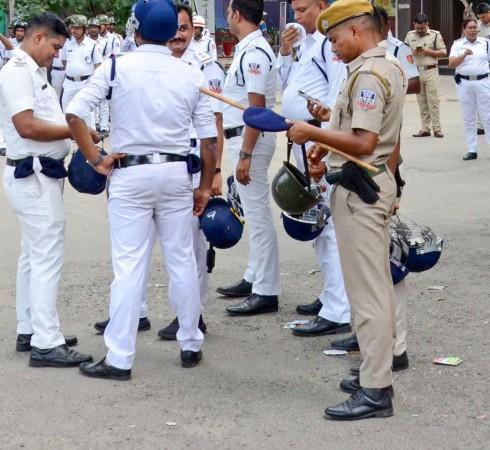
Security and intelligence agencies in India have ramped up their alert levels across seven districts in West Bengal. This heightened vigilance follows intelligence reports indicating that the Bangladesh-based fundamentalist group, Jamaat-ul-Mujahideen Bangladesh (JMB), is planning to establish operational modules in minority-dominated areas within these districts. The districts under scrutiny include Malda, Murshidabad, North Dinajpur, North 24 Parganas, South 24 Parganas, Nadia, and Birbhum.

The intelligence inputs, which have prompted this heightened state of alert, were primarily gathered through the interrogation of three recently apprehended JMB associates. These individuals, Aazmal Hossain and Saheb Ali Khan from Birbhum, and Abasuddin Molla from South 24 Parganas, were arrested last month. Their capture has provided crucial insights into the JMB's operational strategies and future plans. Additionally, on-field intelligence gathered by both central and state agencies has corroborated these findings, painting a comprehensive picture of the threat landscape.
BIG BREAKING NEWS ?? - Security in 7 Bengal districts on high alert over Bangladesh-based JMB’s plans for modules ? ?
— Times Report (@timesreport_) June 8, 2025
https://t.co/CgvJXhJIxz pic.twitter.com/qNVsWiMtM5
The JMB's strategy appears to be a two-phase plan. Initially, the group aims to establish its presence in the districts of Malda, Murshidabad, and North Dinajpur. Following the successful establishment of modules in these areas, the group plans to expand its operations to North 24 Parganas, South 24 Parganas, Nadia, and Birbhum. This phased approach suggests a calculated effort to infiltrate and influence sensitive regions within both North and South Bengal.
JMB's Strategic Expansion and Modus Operandi
An insider from the state police has revealed that the JMB's plan is meticulously designed to cover the most sensitive pockets in these regions. While North Dinajpur and Malda are located in the northern sector of the state, the other five districts are situated in the southern sector. Notably, except for Birbhum, all these districts share international borders with Bangladesh, making them strategically significant for cross-border operations.
Birbhum, despite not having an international border, plays a crucial role as a connecting route between South Bengal and North Bengal via Murshidabad. This geographical significance is underscored by past investigations, such as the Central Bureau of Investigation's (CBI) probe into a multi-crore cattle-smuggling case, which identified Birbhum as a key transit route to Bangladesh through Murshidabad.
The modus operandi of the JMB involves initially brainwashing youths, including minors, and subsequently recruiting them into sleeper cells. The police have identified several youths who were targeted by the arrested JMB activists. These individuals were reportedly contacted individually and encouraged to participate in programs ostensibly meant for religious teachings. However, the underlying motive of these programs was to indoctrinate the youths and prepare them for induction into the JMB's local sleeper cells. During these sessions, participants were exposed to books and videos that, under the guise of religious texts, subtly propagated the ideology of jihad.
Investigative Findings and Broader Implications
The investigation has also uncovered links between the arrested JMB associates and other fundamentalist groups. Coded and encrypted messages recovered from the mobile phones of Aazmal Hossain and Saheb Ali Khan revealed connections with associates of Bangladesh-based outfits such as Hizb-ut-Tahrir (HUT) and Ansarullah Bangla Team (ABT). Meanwhile, similar messages from Abasuddin Molla's phone indicated regular communication with individuals based in Pakistan and associates of the Jammu and Kashmir-based group Ansar Ghazwat-ul-Hind.
The arrest of these individuals has provided a wealth of information, enabling the authorities to track the Pakistan links of Abasuddin Molla. This aspect of the investigation is particularly concerning, as it suggests a broader network of collaboration between JMB and other extremist groups operating in the region. The current situation in West Bengal is reminiscent of past incidents where extremist groups have attempted to establish a foothold in the region. Historically, the porous borders between India and Bangladesh have posed significant challenges for security agencies, facilitating the movement of individuals and resources across the border. This has necessitated a robust and coordinated response from both central and state agencies to counter the threat posed by such groups.
In response to the current threat, security agencies have intensified their surveillance and monitoring efforts across the targeted districts. This includes increased patrolling, intelligence gathering, and community engagement to prevent the radicalization of vulnerable individuals. The authorities are also working closely with local communities to raise awareness about the tactics employed by extremist groups and to encourage cooperation with law enforcement agencies.
The situation in West Bengal underscores the need for a comprehensive and multi-faceted approach to counter-terrorism. This includes not only addressing the immediate threat posed by groups like JMB but also tackling the underlying factors that contribute to radicalization and extremism. Efforts to promote social cohesion, economic development, and education in vulnerable communities are essential components of a long-term strategy to prevent the spread of extremist ideologies.
As the investigation continues, the authorities remain vigilant, committed to thwarting the plans of JMB and ensuring the safety and security of the people in West Bengal. The collaboration between central and state agencies, along with the support of local communities, will be crucial in addressing this complex and evolving threat.

















